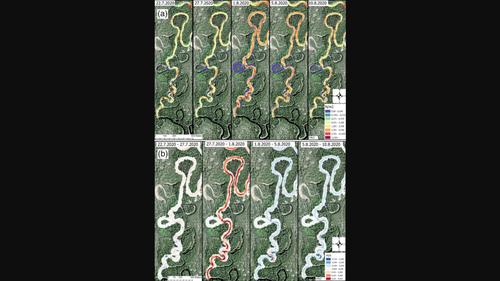当前位置:
X-MOL 学术
›
Hydrol. Process.
›
论文详情
Our official English website, www.x-mol.net, welcomes your
feedback! (Note: you will need to create a separate account there.)
Impacts of rising, peak and receding phases of discharge events on erosion potential of a boreal meandering river
Hydrological Processes ( IF 2.8 ) Pub Date : 2022-08-17 , DOI: 10.1002/hyp.14674 Marko Kärkkäinen 1 , Eliisa Lotsari 1, 2
Hydrological Processes ( IF 2.8 ) Pub Date : 2022-08-17 , DOI: 10.1002/hyp.14674 Marko Kärkkäinen 1 , Eliisa Lotsari 1, 2
Affiliation

|
Flow features of a meandering river can vary seasonally and widely in the boreal zone, as seasonal variation in discharges affect the properties of meander bends and the spatial location of flow magnitudes. However, a better understanding of the impacts of consecutive high-discharge events in the boreal zone requires further analyses. Thus, the impacts of the fluvial processes and their magnitudes on different types of meander bends (e.g., sinuosity, symmetricity) were analysed throughout an open-channel flow period, using accurate flow measurements and hydrodynamic (two-dimensional) modelling. In particular, the research compared the impacts of different discharge events in magnitude and length of river evolution, and whether there is a difference in the erosion forces of the rising and falling phases of discharge hydrographs, and which of the phases has the greatest relevance to erosion forces. A case study was carried out in a middle boreal zone meandering river (Koitajoki in eastern Finland) during the 2020 open water season from May to October. Five different types of meander bends were considered in the study area. Flow magnitudes and shear forces were at their strongest during the spring flood peak, which is normally considered as the highest flow event during the hydrological year. Exceptionally, the largest summer discharge event reached a level that was close to the spring floods' maximum erosional capabilities. Bed shear stress values indicated the falling phases of the flood hydrographs are more important to river evolution than during the ascent stage, as the long duration of the flood downstage contributes more strongly to meander bend erosion and development. The smaller the curvature and larger the sinuosity of the bends, the more variation in erosional forces occurs between discharge stages. The study provides new insights into seasonal fluvial processes in boreal river meander bends as well as reinforces results from earlier river studies.
中文翻译:

流量上升、高峰和消退阶段对北方曲流河流侵蚀潜力的影响
曲折河流的流量特征在北方地区会随季节而广泛变化,因为流量的季节性变化会影响曲折弯道的特性和流量大小的空间位置。然而,要更好地了解北方地区连续高排放事件的影响,需要进一步分析。因此,使用精确的流量测量和流体动力学(二维)建模,在整个明渠流动期间分析了河流过程及其幅度对不同类型的曲折弯道(例如,弯曲度、对称性)的影响。特别是,研究比较了不同泄流事件对河流演化幅度和长度的影响,以及泄流过程线上升和下降阶段的侵蚀力是否存在差异,以及哪个阶段与侵蚀力的相关性最大。在 2020 年 5 月至 10 月的开放水域期间,在中部北方地区蜿蜒的河流(芬兰东部的 Koitajoki)进行了案例研究。研究区域考虑了五种不同类型的曲折弯。在春季洪水高峰期,流量和剪切力最强,这通常被认为是水文年的最高流量事件。异常地,最大的夏季泄洪事件达到了接近春季洪水的最大侵蚀能力的水平。河床剪应力值表明洪水过程线的下降阶段对河流演化的影响比上升阶段更重要,因为洪水下游的长期持续时间对曲折弯侵蚀和发展的贡献更大。弯曲的曲率越小,弯曲度越大,放电阶段之间的冲刷力变化就越大。该研究为北方河流曲折弯的季节性河流过程提供了新的见解,并加强了早期河流研究的结果。
更新日期:2022-08-17
中文翻译:

流量上升、高峰和消退阶段对北方曲流河流侵蚀潜力的影响
曲折河流的流量特征在北方地区会随季节而广泛变化,因为流量的季节性变化会影响曲折弯道的特性和流量大小的空间位置。然而,要更好地了解北方地区连续高排放事件的影响,需要进一步分析。因此,使用精确的流量测量和流体动力学(二维)建模,在整个明渠流动期间分析了河流过程及其幅度对不同类型的曲折弯道(例如,弯曲度、对称性)的影响。特别是,研究比较了不同泄流事件对河流演化幅度和长度的影响,以及泄流过程线上升和下降阶段的侵蚀力是否存在差异,以及哪个阶段与侵蚀力的相关性最大。在 2020 年 5 月至 10 月的开放水域期间,在中部北方地区蜿蜒的河流(芬兰东部的 Koitajoki)进行了案例研究。研究区域考虑了五种不同类型的曲折弯。在春季洪水高峰期,流量和剪切力最强,这通常被认为是水文年的最高流量事件。异常地,最大的夏季泄洪事件达到了接近春季洪水的最大侵蚀能力的水平。河床剪应力值表明洪水过程线的下降阶段对河流演化的影响比上升阶段更重要,因为洪水下游的长期持续时间对曲折弯侵蚀和发展的贡献更大。弯曲的曲率越小,弯曲度越大,放电阶段之间的冲刷力变化就越大。该研究为北方河流曲折弯的季节性河流过程提供了新的见解,并加强了早期河流研究的结果。











































 京公网安备 11010802027423号
京公网安备 11010802027423号